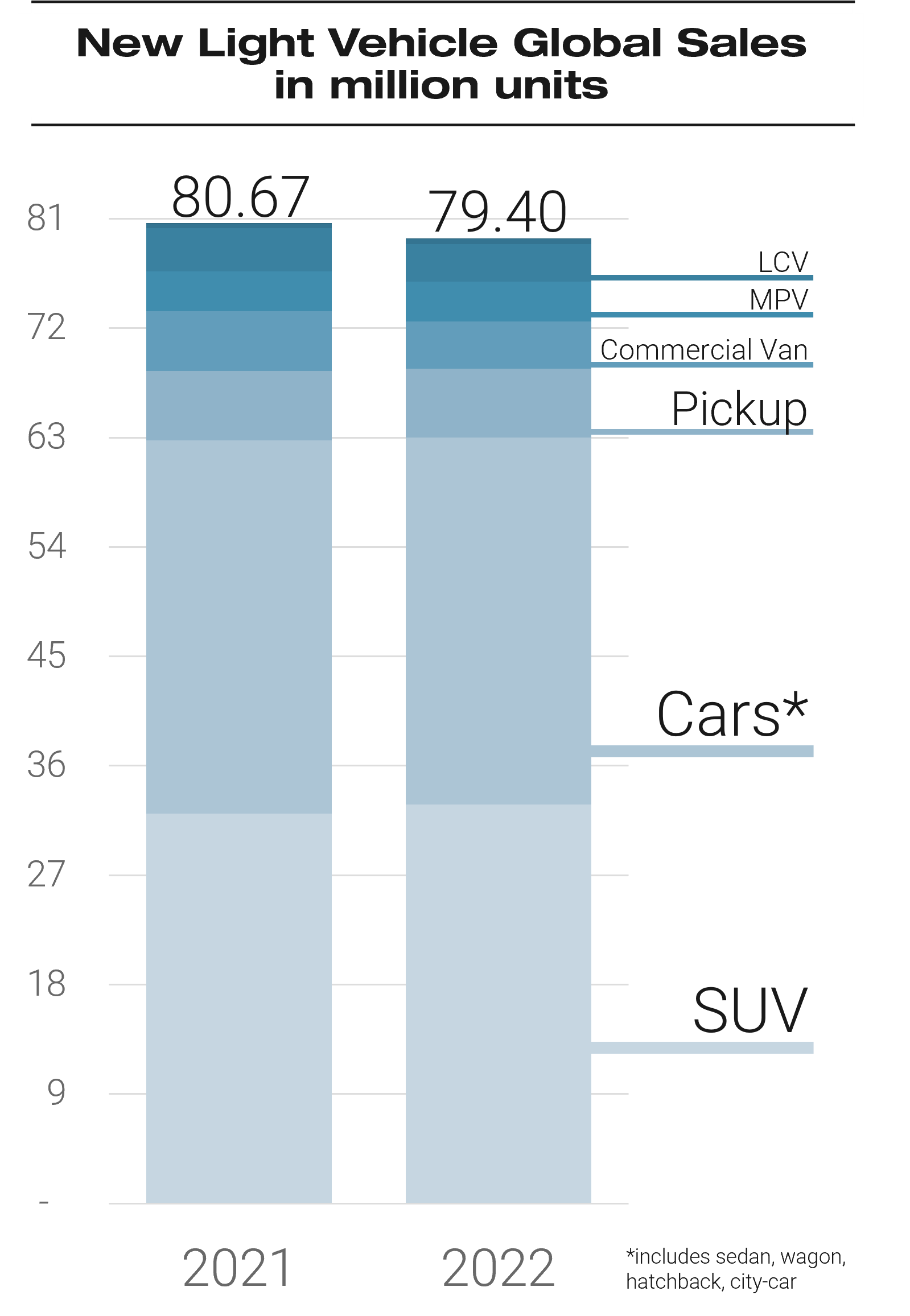- The global new vehicle market fell by 2% year-on-year
- Emerging markets accounted for 24% of sales
- BEV volumes surged by 66%
- Toyota led the rankings by OEM, while China’s OEMs gained market share
- Tesla continued to climb the model ranking
According to JATO Dynamics data, 79.4 million new vehicles were registered globally in 2022 marking a 2% decrease on the 80.7 million units registered in 2021. Positive results in several emerging markets (India, Middle East, South East Asia, Africa), which represented 24% of global volumes, were significant enough to offset declines seen in North America, Europe, and China.
Felipe Munoz, Global Analyst at JATO Dynamics, commented: “This decline can be attributed to two key factors. Firstly, ongoing supply chain disruption and the shortage of semiconductors in North America and Europe led to a reduction in the availability of new vehicles, while sales in China, the world’s largest market, weakened.” In 2022, the three regions combined accounted for 69% of total global sales.

In addition to these challenges, the ongoing war in Ukraine also contributed to the decline. As a result of sanctions, the Russian market suffered heavily with sales dropping by 59% – equating to approximately 1 million units. “The market is shifting away from NSCs and OEMs, instead becoming increasingly reliant on importers. The withdrawal of Western brands has created an opportunity for China to expand its presence in the Russian car market – the 21st largest in globally 2022”, commented Irina Dedova, JATO Dynamic’s Area Manager for Eastern Europe.
In contrast, demand in India soared by 24%, to a new record of 4.37 registered million units. These results saw India surpass Japan to become the world’s third largest car market. Despite the increase in volume, just 3.1 vehicles were sold per 1,000 inhabitants – the lowest among the top 25 largest vehicle markets.
Ravi Bhatia, President and Director at JATO Dynamics India, commented: “Consumer confidence has been bolstered by the recovering economy and supportive government policies including production-linked incentives totaling $7.5 billion over the next five years to encourage exports, and the introduction of a new vehicle scrappage policy to boost demand for new vehicles. Banks and financial institutions have also become more accommodating in offering loans at competitive rates”.
Financial incentives, post-pandemic measures and benefits helped to boost demand in the Middle East. New vehicle registrations across the six countries of the Gulf Cooperation Council reached 2.75 million units – 46% of the regional total. Samir Sawalhi, Vice President at JATO Dynamics Middle East, added: “The Middle East looks set to take on a more significant role in the global automotive industry; Saudi Arabia – the world’s 19th largest car market – aims to become a hub for electric vehicle production with investment expected to reach $50 billion over the next ten years.”
In the African market, volume increased by 5.5% to 1.15 million units. This was driven by a 14% increase in registrations in South Africa – the continent’s largest market, accounting for 44% of the total. Northern Africa’s volume accounted for 42% of the continent’s total while Southern Africa represented 45%. In contrast, Eastern, Central, and Western Africa accounted for 4.8%, 1.3%, and 6.7% of the total respectively.
The EV surge continues
In 2022, the total volume of battery electric vehicles (BEVs) surged by 66% to a total of 7.37 million units – a year on year increase of 2.9 million units. This exceeded the increase of 2.4 million units seen between 2020 and 2021. Last year, the global market share for BEVs jumped from 5.5% in 2021 to 9.3%. Regionally, only China and Europe secured a double-digit share of the market with 15.6% and 12.2% respectively.

Felipe Munoz, JATO’s Global Analyst, commented: “The EV boom looks set to endure. Governments in the developed world have continued to offer generous incentives, encouraging consumers to make the switch away from ICE vehicles, while average prices have decreased thanks to the introduction of more affordable models by OEMs.”
Norway continued to set the standard for EV adoption globally. Last year, 71% of light vehicles registered in the country were BEVs, however it was Hong Kong that recorded the highest market share increase from 24.4% in 2021 to 53.1% last year. “The scrappage program for those vehicles at least six years old, and the tax exemption for new electric vehicles up to certain price is pushing many consumers to make the switch from petrol to electric” commented Bo Yu, Area Manager for JATO Dynamics China.
China led the way as world’s largest market in terms of volume, accounting for 53% of global sales – a significant margin more than the country’s share of overall global light vehicle sales at 32%. China’s success is the result of shorter waiting times for BEVs when compared with ICE models and a burgeoning offer for consumers – in 2022, 15 new brands were launched in China. While Tesla led the EV charge in 2022 with a 43% growth in sales, the US manufacturer lost market share to China’s OEMs, down 3 points of share to 17.6%.
Toyota leads again
In 2022, Toyota was the world’s best-selling OEM, accounting for 13 of every 100 new light vehicles purchased. The Japanese manufacturer was able to increase its global market share by 0.3 points thanks to strong results in China – now its largest market ahead of the US and Japan. These results are explained by Toyota’s strong offering across both hybrids and SUVs – in 2022, Toyota outsold Volkswagen Group to emerged as the world’s best-selling SUV maker.

As in 2021, Volkswagen Group secured second place behind Toyota in the rankings by OEM, however it saw a volume decrease of 10%, losing 0.7 points of share. In China, the manufacturer’s second largest market, sales fell by 6% as a result of increasing local competition, however it remained the leading OEM in both China and Europe.
Hyundai-Kia followed in third place as a result of its strong market position in Korea, India, North America, and Europe. Unlike its rivals in Europe and the US, Hyundai-Kia has a relatively widespread sales distribution, with 71% of global sales spanning across 4 regions. In fourth place, Stellantis saw a total volume of 5.8 million units – down by 10%. In Europe, its sales dropped by 14% with supply chain issues affecting the availability of vehicles. Despite this, Stellantis was the best-selling OEM in Latin America. General Motors sold 4.6 million units to close out the top five, with Chevrolet accounting for 62% of its total (excludes the Joint-Venture volume with SAIC-Wuling).
In 2022, the fastest growing OEM was BYD. The Chinese OEM was able to gain 1.5 points of the global market share due to its strong offering across all mainstream segments and competitive EV line-up. BYD followed Tesla as the world’s second best-selling BEV manufacturer, with a volume increase of 184%, to more than 911,000 units in 2022. For OEMs like Suzuki, Mahindra, and Tata, increased demand in India meant their volumes also accelerated.
Tesla among the top-selling models
Tesla placed 2 of its 4 models available in 2022, in the top 10 ranking. According to JATO data for 53 markets, alongside further research and estimations for a further ninety five markets, the Tesla Model Y was the world’s third best-selling passenger vehicle in 2022 – only behind traditional super-sellers, the Toyota RAV4, and Toyota Corolla/Levin sedan.
Munoz, continued: “It is a historic moment to see a pure electric vehicle not only so close to the top position, but a relatively new brand getting so far in the global ranking, particularly given they are not the most affordable vehicles.”
Further down, the Tesla Model 3 occupied 10th position – however, losing 1 position compared to 2021. Toyota placed 5 models in the top 10, while Ford, Nissan and Honda placed one model each.

Global gains for Chinese OEMs
Another interesting trend to emerge last year was the increasingly influential role Chinese brands are playing outside China. In 2022, almost 1.5 million light vehicles made by Chinese OEMs were sold outside China – a 48% increase when compared with 2021. This growth was driven by a more competitive, higher quality offering, and a big push in the affordable EV segments.
China’s manufacturers are finding ways to ehance their position in the global market. While some are introducing products to new markets directly, other are rebadging their vehicles and selling them under brands that are well-established in Western markets. In addition, some Chinese carmakers are producing vehicles for Western OEMs that have ambitions to increase their presence in markets through a more competitive product offering.

The growth of China’s OEMs is also being felt in emerging markets where their market share jumped from 4.8% in 2021 to 6.4% last year. While this remains a relatively small percentage, China’s manufactuers have been successful in taking market share away from the European and Korean carmakers. In regions like Eurasia, the market share of China’s OEMs more than doubled, increasing from 6.2% in 2021 to 12.8% in 2022.
SUVs gain further traction
Despite the overall market falling by almost 2% between 2021 and 2022, sales of SUVs increased by 2.3% to a record 32.8 million units. The global market share for these vehicles jumped from 39.7% in 2021 to 41.3%.
SUVs saw the fastest growth in Europe, with a market share increase of 4.3 points, reaching a new record of 43% of all light vehicle sales – the second highest globally. In North America, SUV sales accounted for 54% of total light vehicle sales, while in China these vehicles represented 41% of the market.
In 2022, the majority of these vehicles sold worldwide were compact SUVs, with a total of 15.6 million units. Sales of small SUVs reached 7.6 million units, followed by midsize SUVs at 5.05 million units, and luxury SUVs at 4.5 million new sales.
The uptick in SUV sales came at the expense of traditional segments such as sedans, hatchbacks, MPVs and wagons which experienced a 2% decline to 33.3 million units. Sales of pickup trucks dropped by 2% due to lower demand in North America –the largest market for these vehicles.

Considering the outlook for 2023, Munoz added: “The decline seen in 2022 was not unexpected given the supply chain issues and global semiconductor shortage that the industry had to contend with. While OEMs were able to weather the storm, new challenges have emerged. As demonstrated by last year’s biggest market share winner, BYD, China’s OEMs at the forefront of the EV transition are rapidly gaining a foothold across markets with an increasingly competive and affordable offering. To meet this challenge, Tesla has started to cut prices and established Western OEMs will be forced to follow suit if they are to maintain their position in the market.”
To hear more about the 2022 results, listen to the first episode of JATO’s new podcast: here
